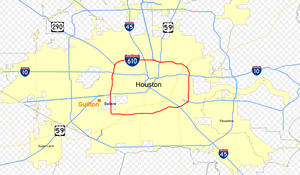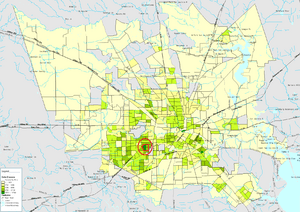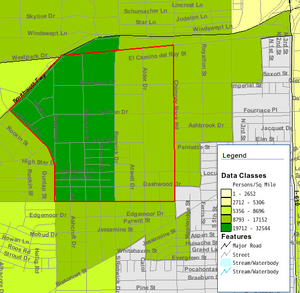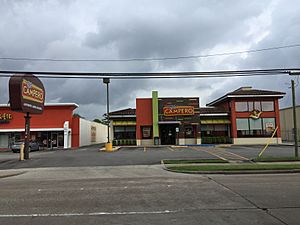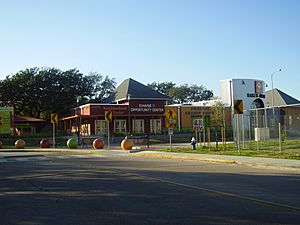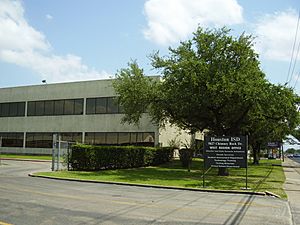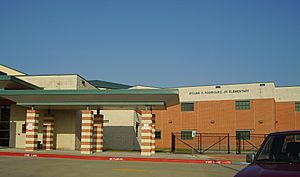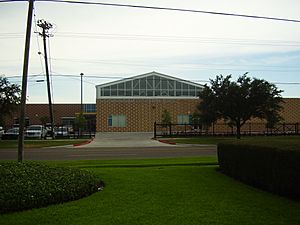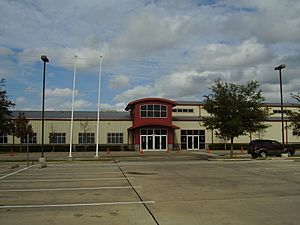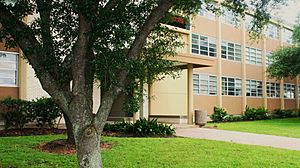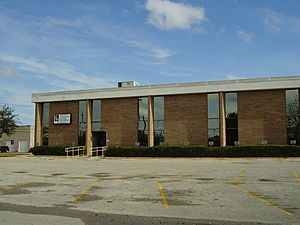Gulfton, Houston facts for kids
Quick facts for kids
Gulfton
|
|
|---|---|
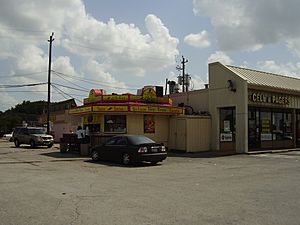
A shopping center in Gulfton
|
|
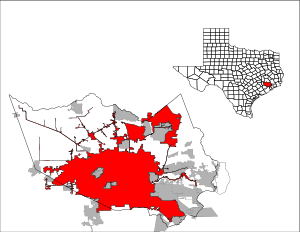 |
|
| Country | United States of America |
| State | Texas |
| Population | |
| • Estimate
(2000)
|
46,287 |
| • Urban density | 14,477/sq mi (5,590/km2) |
| Time zone | UTC-6 (CST) |
| • Summer (DST) | UTC-5 (CDT) |
Gulfton is a neighborhood in Southwest Houston, Texas, United States. It covers about 3.2 square miles (8.3 km2). It's located between the 610 Loop and Beltway 8, west of Bellaire, and near Interstate 69/U.S. Highway 59.
Gulfton has a unique history. In the 1960s and 1970s, many new apartment buildings were built here. They were for young people from other parts of the U.S. who came to work in the oil industry during the 1970s oil boom.
But in the 1980s, the oil economy slowed down. Many people moved away, and apartments became empty. This led to many buildings going bankrupt. To fill the empty homes, owners started renting to new immigrants. Because of this, Gulfton became a community mostly made up of immigrants.
By 2000, Gulfton was the most crowded neighborhood in Houston. About 71% of its residents were Hispanic. Many of them were new immigrants from Mexico and Central America. While it was traditionally a Salvadoran and Mexican area, people now come from many different Latin American countries. This includes Venezuela, Honduras, Cuba, Guatemala, and Colombia. There are also American citizens from places like Puerto Rico.
Contents
Gulfton's Location and Landscape
Gulfton is in Southwest Houston, just outside the 610 Loop. It's about 10 miles (16 km) southwest of Downtown Houston. It's also about 2 miles (3.2 km) west of Bellaire. Experts describe Gulfton as an "inner ring" area of Greater Houston. This means it's between the city center and the suburbs. It mixes city and suburban features.
Gulfton has about 90 apartment complexes with over 15,000 homes. Many of these apartments were built for single adults. So, they don't always have features that families need. Some apartment buildings are very long, even over a city block. In the 1970s, one complex had 17 swimming pools!
You can also find strip malls and office buildings in Gulfton. Some apartments even have small businesses on the ground floor. You might see beauty salons, small shops, and tire repair places. This shows how creative residents are in using the space.
Streets and Sidewalks in Gulfton
The city blocks in Gulfton are much larger than those in Downtown Houston. Sixteen downtown blocks could fit into one Gulfton block. There are not many sidewalks in Gulfton. In 1999, a city official noted that pregnant women had to walk on the sides of the roads. In 2005, Gulfton was named one of the most dangerous places for people walking. In 2019, a group called Together for Safer Roads planned to study how to make streets safer for walkers and bikers.
Napoleon Square Apartments
One famous apartment complex is Napoleon Square. It was built in 1971 for $22 million. It had 1,884 units, a disco, and many swimming pools. In 1977, it had a main pool, 12 other pools, and a club.
By 1999, about 1,500 families lived there. Most were from Mexico, Central America, and South America. As of 2003, many families came from Mexico, Honduras, and other Central and South American countries. Napoleon Square and Lantern Village together have over 1,000 units and thousands of residents.
Gulfton's Population Changes
Between 1980 and 2000, Gulfton's population almost doubled. This happened without many new homes being built. The number of Hispanic residents grew from 18,422 in 1990 to 33,424 in 2000. This was an 81% increase. At the same time, the number of non-Hispanic White residents went down.
More people started living in each apartment. For example, Napoleon Square went from 60% full in 1996 to over 95% full in 2001. This increase was also partly due to better efforts to count everyone in the census.
Car Ownership in Gulfton
In 2021, about 12% of homes in Gulfton did not have cars. The average for Houston was around 6%. This means more people in Gulfton rely on walking, biking, or public transport.
Gulfton's Economy
Gulfton has many small businesses and light industrial areas. When many immigrants arrived in the mid-1980s, there weren't enough jobs for everyone. This led to higher unemployment. Families often shared homes to save money.
Many businesses in Gulfton are "mom and pop businesses." These are small, family-owned shops. The Houston Metropolitan Chamber helps with economic support in Gulfton.
Local Businesses and Services
As of 2005, many Central American businesses have stores in Gulfton. For example, ADOC footwear has its only U.S. store here. Pollo Campero has a restaurant in Gulfton. Salvadoran banks also have branches in the area. Many small grocery stores and restaurants are owned by Salvadoran refugees. Grupo TACA, an airline group, has a center in Gulfton. Famsa, a Mexican furniture store, also has a location nearby.
You'll often see paleteros (food vendors) on bicycles. They sell snacks like spiced cucumbers and popsicles (paletas).

In 2003, Kroger changed its Gulfton supermarket to better serve the new Hispanic population. However, in 2010, Kroger closed this store because it wasn't making enough money.
Business Development
In 2001, a new shopping center called Plaza de Americas was built. It cost $4 million and was designed to attract stores for Hispanic customers. Developers believed the large Hispanic population in Gulfton would make the center successful.
Gulfton's Culture and Community

Gulfton is often called the "Ellis Island of the current time." This means it's a place where many new immigrants arrive. People from 70 different cultures live here, speaking 30 different languages. It's one of the most crowded areas in Houston.
Gulfton offers affordable housing, shops, and food that help new residents feel at home. Many immigrants stay in Gulfton because of stores like Fiesta Mart that cater to them. People once thought immigrants would move away, but many have stayed and become long-term residents. In 2010, Gulfton was described as a "microcosm of Houston" because of its wide range of ethnic foods and restaurants.
Soccer in Gulfton
Soccer (football) is very popular in Gulfton. The Southwest Houston Soccer Association was started in the 1990s. Before that, there were only adult teams, no youth leagues. Playing soccer helps keep young people active and away from negative influences.
Community Centers and Services
Neighborhood Centers Inc. has been working in Gulfton for many years. In 1998, they opened El Puente (The Bridge) at the Napoleon Square Apartments. This center provides support to the community. It has offices and play areas in converted apartment units.
Many groups offer services at El Puente. The Houston Public Library teaches reading, Houston Community College offers English classes, and the Houston Independent School District has preschool programs. The University of Houston helps with social work assessments. The Sisters of Charity provide health services. The center helps children who have few activities available.
The Baker-Ripley Neighborhood Center opened in 2009. It's a large campus with five buildings. It has a farmers market, a health clinic, an outdoor movie area, a public library, and a school. The center's design uses ideas from Mexican and South American art. It was designed with input from Gulfton residents. The center offers English and computer classes. It also has a program called Gulfton Promise Project, which helps residents from birth through their careers.
Health Care in Gulfton
Texas Children's Pediatric Associates Gulfton is a health care center for children. It helps families who might have trouble paying for health care. This center helps them get regular check-ups instead of only going to the emergency room.
In 2004, many promotoras (health promoters) worked in Gulfton. These are people from the community who learn about health care from doctors. Then, they go back to their communities to teach others. This idea comes from Latin America.
Social Life in the Past
Before the population changed, residents at Napoleon Square used to socialize at the swimming pools. Nightclubs were also popular. However, people from different ethnic groups often kept to themselves. One person said that even though it was diverse, it wasn't really a "melting pot."
Religion in Gulfton
The Roman Catholic Archdiocese of Galveston-Houston runs Holy Ghost Church in Gulfton. It's a large church with about 4,000 regular members. It holds services in both English and Spanish. Volunteers created beautiful stained glass windows for the church.
Besides the Catholic church, there are many "storefront churches." These are smaller churches for different Christian groups, often located in former shops.
Education in Gulfton
Gulfton is part of the Houston Independent School District (HISD). This means students attend public schools run by HISD.
Elementary and Middle Schools
Children in Gulfton attend one of these elementary schools: Benavidez, Braeburn, Cunningham, or Rodriguez. For middle school, most students go to Jane Long Middle School. They also have the option to attend Pin Oak Middle School in Bellaire. Pin Oak is a highly rated school.
Gabriela Mistral Early Childhood Center is the closest early childhood center for Gulfton. It serves students who are poor, homeless, or don't speak English well. Las Américas Middle School and Kaleidoscope Middle School are also options, located on the Long Middle School campus.
Charter Schools in Gulfton
Gulfton has several state charter schools. These are public schools that operate with more freedom than traditional public schools.
- SER-Niños Charter School serves pre-kindergarten through 8th grade. Most students are of Mexican and Salvadoran descent.
- Amigos Por Vida Friends For Life Charter School serves pre-kindergarten 3 through 8th grade.
- YES Prep Gulfton is a middle and high school. Many of its students are from the Gulfton area.
- The Baker-Ripley Charter School is at the Baker-Ripley Neighborhood Center.
- KIPP Houston operates KIPP: Connections nearby.
Private Schools in Gulfton
There are also private schools in Gulfton. Robindell Private School serves preschool through 3rd grade and has a 24-hour daycare. Holy Ghost School is a PreK-8 Roman Catholic school.
School Transportation
Most children in Gulfton live close to their elementary schools. This means they usually don't get free school bus transportation. Many children walk or ride bicycles to school.
History of Gulfton Schools
Cunningham Elementary, the first school in Gulfton, opened in 1953. Braeburn Elementary opened in 1956, and Long Middle School opened in 1957.
By the 1980s, Cunningham Elementary became very crowded. Its enrollment jumped from 500 students in 1985 to over 900 in 1986. Many students were Hispanic, and most qualified for free or reduced-cost lunches. Many came from Central American countries and had not received much schooling before.
Benavidez Elementary School opened in 1992 to help with the overcrowding at Cunningham. It took about 675 students from Cunningham. However, Benavidez quickly became crowded too.
Rodriguez Elementary opened in 2002 to help relieve Benavidez, Braeburn, and Cunningham. Pin Oak Middle School also opened in 2002 to help with crowded middle schools in the area.
The Las Américas Education Center, which included a preschool and two middle schools, started in 1995. It helped with overcrowding at Cunningham and Benavidez. In 2007, this center closed, and its middle schools moved to the Long Middle School campus.
High Schools in Gulfton
Most high school students in Gulfton attend Margaret Long Wisdom High School (formerly Robert E. Lee High School). They can also choose to go to Lamar High School or Westside High School. When Wisdom High School first opened, it had mostly wealthy white students. Over time, it changed to mostly Hispanic and immigrant students.
Some parts of Gulfton are zoned to Bellaire High School. HISD also has Liberty High School, a charter high school specifically for recent immigrants. In 2014, HISD opened Middle College High School-Gulfton at the HCC Gulfton facility. This is a special high school program for 150 students.
Challenges for Students
By the late 1990s, 75% of Gulfton students qualified for free or reduced-price lunches. Almost 95% of students were considered economically disadvantaged. More than 70% of students had trouble with English.
Missing school was a big problem in Gulfton. Language barriers, lack of parent supervision, and families moving often made it hard for students to attend regularly. The City of Houston started a project to help reduce truancy (missing school) in Gulfton.
Community Colleges
Gulfton is served by the Houston Community College System (HCCS). HCCS operates the Gulfton Center, which is part of its Southwest College. This center offers college classes and programs to the community.
Libraries
The Houston Public Library (HPL) has a branch called HPL Express Southwest. It's located at the Southwest Multi-Service Center, next to Gulfton. Before this library opened in 2008, there were no libraries close to Gulfton.
See also
 In Spanish: Gulfton (Houston) para niños
In Spanish: Gulfton (Houston) para niños
- Southwest Houston
- History of the Central Americans in Houston
- Districts and communities of Houston
- Geographic areas of Houston
- Forum Park, Houston
- Link Valley, Houston
- Thai Xuan Village
Images for kids


